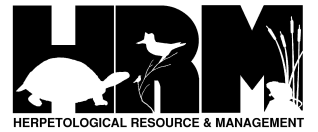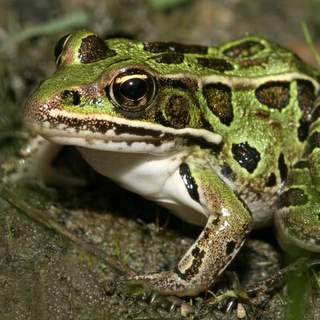Northern Leopard Frog
Overview:
Scientific Name: Rana pipiens
Size: 2 – 4.4”
Status: Were abundant in the Great Lakes region until the early 1980s, when notable declines were suffered. Currently uncommon or rare in many areas, but can be locally abundant in suitable habitat
MDNR Wildlife Action Plan Status: Species of Greatest Conservation Need
Habitat:
Found in open habitats such as marshes, bogs, lake and stream edges, fields, meadows, and suburban lawns.
Adult Coloration:
Green, greenish brown, or brown to copper, with a number of rounded dark spots on back and sides, and spots or bars on legs. Spots may have whitish or yellowish borders. Usually dark spot over each eye and on the snout. White line from nose to shoulder extended as light dorsolateral folds (two ridges of raised skin down the back). Upper lip also often has a white strip bordered to the bottom by a black blotched line. Belly white to very pale green, sometimes with yellow tint in the groin.
Adult Characteristics:
Males have thickened pads on thumbs, are usually smaller than females, and during calling display paired vocal sacs over shoulders. There is no difference in the size of the tympanum between sexes. Females may appear very fat when gravid (carrying eggs). Voice: Low, rumbling snore punctuated with hoarse croaks. e.g., http://www.youtube.com/watch?v=VDuvK0u8XyY Both males and females may produce a vibrating “release call” when clasped by a male.
Larvae Characteristics:
Tadpole reaches a maximum length of 3.3”. Has a green, olive, or brown back, often with yellow or brown speckles. Belly is iridescent white or cream with intestine visible.
Species Confused With:
The Pickerel Frog has more angular spots that are paired in rows between the dorsolateral folds, and has bright yellow or orange groin and inner thighs.
References:
- Amphibians and Reptiles of the Great Lakes Region by Jim Harding
- Harding, J.H. and J.A. Holman. 1992. Michigan Frogs, Toads, and Salamanders. MSU Cooperative Extension Service and MSU Museum. Extension Bull. E-2350, 144 pp.
- Ruthven, A. G., H. B. T. Gaige, et al. 1912. The herpetology of Michigan, by Alexander B. Ruthven. Crystal Thompson and Helen Thompson; Memoranda towards a bibliography of the archaeology of Michigan, by Harlan I. Smith; prepared under the direction of Alexander G. Ruthven. Lansing, Mich., Wynkoop Hallenbeck Crawford, State Printers.
- Holman, J. A. 2012. The Amphibians and Reptiles of Michigan: A Quaternary and Recent Faunal Adventure. Detroit, Mich., Wayne State University Press.
- Conant, R., and Collins, J. T. 1998. Reptiles and Amphibians: Eastern, Central North America. Houghton Mifflin Harcourt Press.

